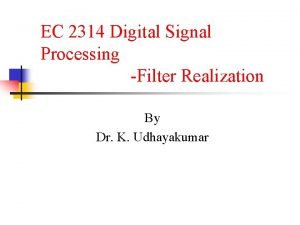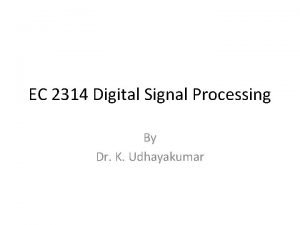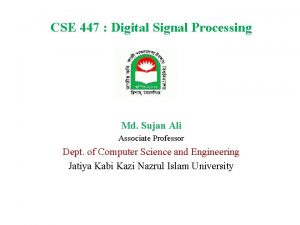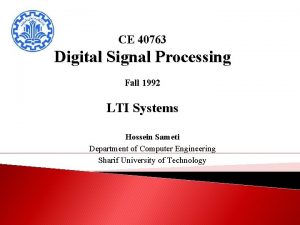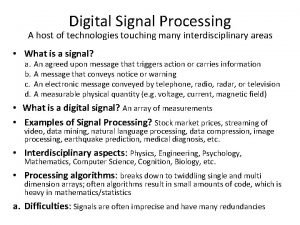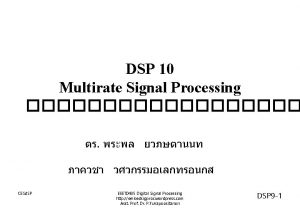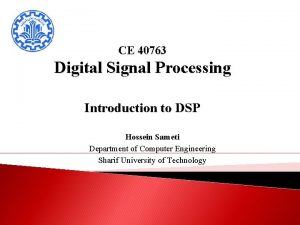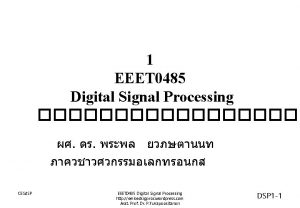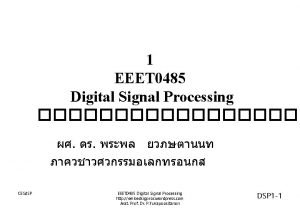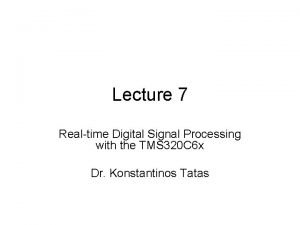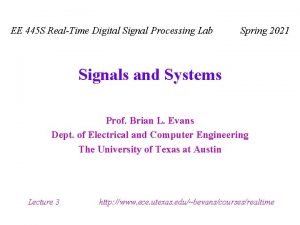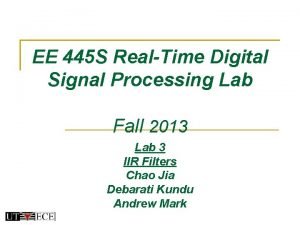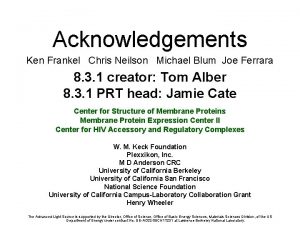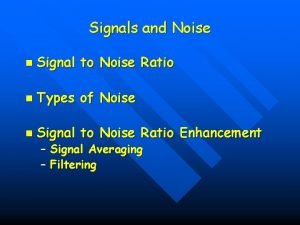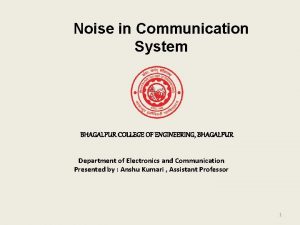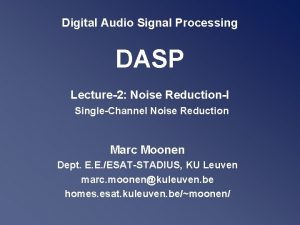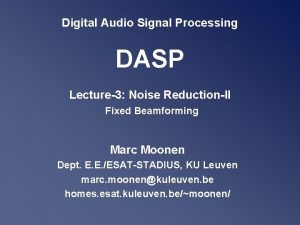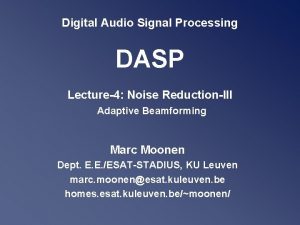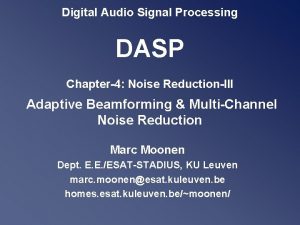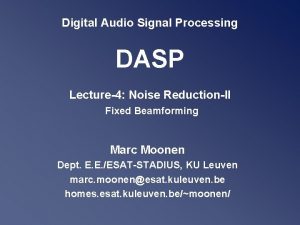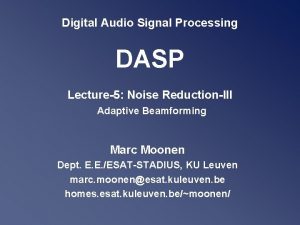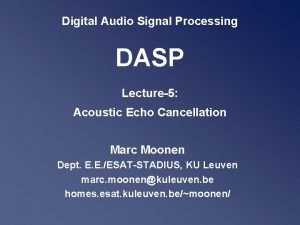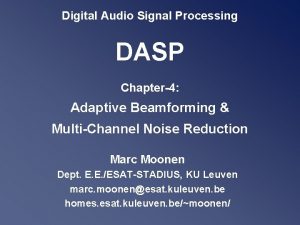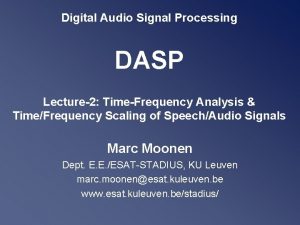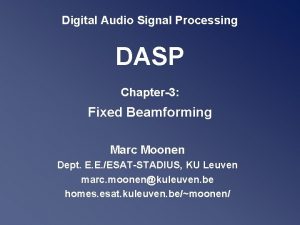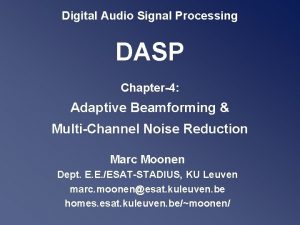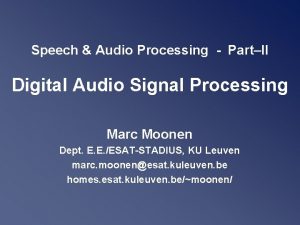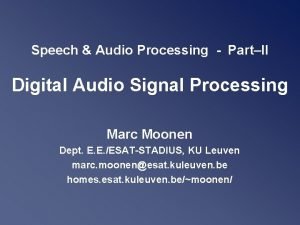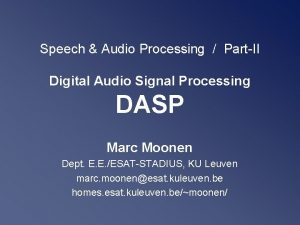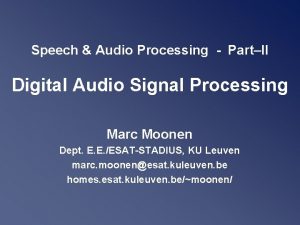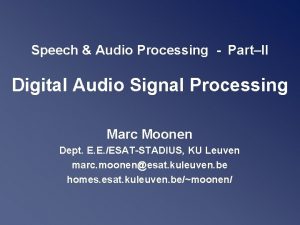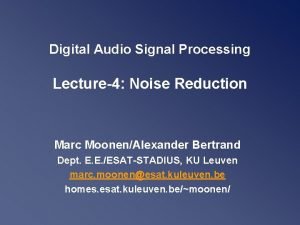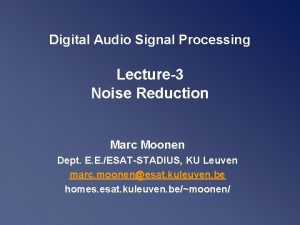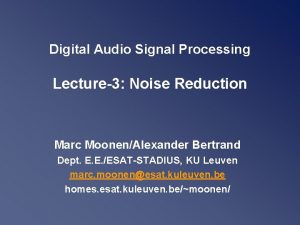Digital Audio Signal Processing DASP Chapter6 Active Noise

























- Slides: 25

Digital Audio Signal Processing DASP Chapter-6: Active Noise Control Marc Moonen Dept. E. E. /ESAT-STADIUS, KU Leuven marc. moonen@kuleuven. be homes. esat. kuleuven. be/~moonen/

Active Noise Control - Outline • Intro - General set-up • Feedforward ANC & Filtered-X LMS • Feedback ANC Reference : S. J. Elliott & P. A. Nelson, `Active Noise Control’, IEEE Signal Processing Magazine, October 1993, pp 12 -35 Digital Audio Signal Processing Version 2020 -2021 Lecture 6 : ANC p. 2 / 25

Active Noise Control - Intro • Passive noise control : sound absorbers, … works well only for high frequencies (`centimeter-waves’) • Active noise control : for low frequencies (e. g. 100 Hz λ=3, 4 m) – General set-up Aim: generate `quiet’ at error microphone ANC works on the principle of destructive interference between the sound field generated by the `primary’ (noise) source and the sound field due to secondary source(s), whose output can be controlled Digital Audio Signal Processing Version 2020 -2021 Lecture 6 : ANC p. 3 / 25

Active Noise Control - Intro PS: Destructive interference relies on superposition & linearity Non-linearity may be due to loudspeakers (=secondary sources). After destructive interference at main frequency, harmonics generated by loudspeakers may become distinctly audible PS: Destructive interference at one point, may imply constructive interference at other point Secondary source to be placed close to error microphone, so that only modest secondary signal is required, and hence points further away from secondary source are not affected. Produce `zone of quiet’ near the error microphone (e. g. 10 d. B reduction in zone approx λ/10) Digital Audio Signal Processing Version 2020 -2021 Lecture 6 : ANC p. 4 / 25

Active Noise Control - Outline • Intro - General set-up • Feedforward ANC & Filtered-X LMS • Feedback ANC Reference : S. J. Elliott & P. A. Nelson, `Active Noise Control’, IEEE Signal Processing Magazine, October 1993, pp 12 -35 Digital Audio Signal Processing Version 2020 -2021 Lecture 6 : ANC p. 5 / 25

Feedforward ANC Basic set-up: d H(z) C(z) primary source x W(z) secondary path e y – C(z) = secondary path = acoustic path from secondary source to error microphone, including loudspeaker and microphone characteristic. C(z) can be modeled/identified, e. g. , based on training sequences (=calibration) – PS: Here ‘feedback’ is in filter coefficient adaptation path Digital Audio Signal Processing Version 2020 -2021 Lecture 6 : ANC p. 6 / 25

Feedforward ANC Design problem: d H(z) C(z) primary source x W(z) secondary path e y – Given C(z), design W(z) that `minimizes’ E(z) – `Ideal’ solution is W(z)=-H(z)/C(z) …but H(z) generally unknown (as in AEC) (ps: see also ✪ p. 22) Digital Audio Signal Processing Version 2020 -2021 Lecture 6 : ANC p. 7 / 25

Filtered-X LMS (1) d H(z) C(z) primary source x W(z) secondary path e y – Straightforward application of LMS : …does not work here (ex. : C(z)=-1, then steepest descent turned into steepest ascent) Digital Audio Signal Processing Version 2020 -2021 Lecture 6 : ANC p. 8 / 25

Filtered-X LMS (2) – This would have been a simpler problem (swap C and W)… d x H(z) C(z) W(z) e y . . . allowing for straightforward application of LMS, with filtered x-signal – PS: Only time-invariant linear systems commute, hence (implicit) swapping will require slow adaptation of W(z) Digital Audio Signal Processing Version 2020 -2021 Lecture 6 : ANC p. 9 / 25

Filtered-X LMS (3) – Filtered-X LMS scheme : swapping of C and W in adaptation path (not in filtering path) d H(z) C(z) x W(z) y e C’(z) x …with C’(z) an estimate of C(z) Digital Audio Signal Processing Version 2020 -2021 Lecture 6 : ANC p. 10 / 25

Filtered-X LMS (4) – Note that adaptation in “first-C’(z)-then-W(z)” (as in p 10) relies on error signal (e) from “first-W(z)-then-C(z)”, which in a sense is inconsistent (see also p 12 -13) – Filtered-X LMS convergence (empirical result) N=filter length W(z) L=filter length C’(z) (hence (long) C(z) implies smaller μ & slower convergence) – Stability also affected by the accuracy of the filter C’(z) modeling the true secondary path C(z) Filtered-X LMS found to be robust to errors in C’(z). . . (details omitted) Digital Audio Signal Processing Version 2020 -2021 Lecture 6 : ANC p. 11 / 25

Filtered-X LMS (5) – Improved version is ‘Modified Filtered-X LMS’ : d H(z) + + C(z) x copy W(z) C’(z) y C’(z) - + d’ (=estimate of d) W(z) e x Digital Audio Signal Processing Version 2020 -2021 Lecture 6 : ANC p. 12 / 25

Filtered-X LMS (6) – Improved version is ‘Modified Filtered-X LMS’ : – Note that adaptation in “first-C’(z)-then-W(z)” now (if C’(z)=C(z), hence d’=d) relies on error signal (e) from “first-C’(z)-then-W(z)”, which is consistent – Hence improved convergence (can use larger step size) – Hence can also replace LMS by RLS (=‘Modified Filtered-X RLS’) Digital Audio Signal Processing Version 2020 -2021 Lecture 6 : ANC p. 13 / 25

Feedforward ANC Additional problem: Feedback F(z) C(z) primary source x d W(z) secondary source e y Feedback from secondary source (loudspeaker) into ref. microphone This is an acoustic echo cancellation/feedback problem : – Fixed AFC based on model of F(z), obtained through calibration, is easy – Adaptive AFC is problematic (combination of 2 adaptive systems) Digital Audio Signal Processing Version 2020 -2021 Lecture 6 : ANC p. 14 / 25

Feedforward ANC Extension: Multiple reference signals/secondary sources/error signals – Applications: airplane/car cabin noise control, active vibration control, . . . – Needs generalization of Filtered-X algorithms, where coefficients of control filters are adapted to minimize the sum of the mean square values of the error signals. Digital Audio Signal Processing Version 2020 -2021 Lecture 6 : ANC p. 15 / 25

Feedforward ANC Multiple Error Filtered-X Algorithms: – – K K reference microphones M secondary sources L error microphones Adaptive filter has Kx. M filters M L (i. e. every reference microphone signal contributes to every loudspeaker signal) – Mx. L different secondary paths between M secondary sources and L error microphones – All K reference microphone signals will have to be filtered (cfr `filtered-X’) by all Mx. L secondary path models, … – …to generate collection of Kx. Mx. L filtered reference microphone signals, which are used in the filter adaptation – Try it! (for a not-too-large scenario) Digital Audio Signal Processing Version 2020 -2021 Lecture 6 : ANC p. 16 / 25

Active Noise Control - Outline • Intro - General set-up • Feedforward ANC & Filtered-X LMS • Feedback ANC Reference : S. J. Elliott & P. A. Nelson, `Active Noise Control’, IEEE Signal Processing Magazine, October 1993, pp 12 -35 Digital Audio Signal Processing Version 2020 -2021 Lecture 6 : ANC p. 17 / 25

Feedback ANC Basic set-up: primary source d secondary source y C(z) W(z) e – C(z) = secondary path (see page 6) – 1 microphone instead of 2 microphones – Applications : active headsets, ear defenders Digital Audio Signal Processing Version 2020 -2021 Lecture 6 : ANC p. 18 / 25

Feedback ANC Design problem: d C(z) y W(z) + e • Given C(z) design W(z) (=feedback control) such that E(z) is `minimized’ • For `flat’ C(z)=Cnt : W(z)=-A for large A (like in an opamp) • For general C(z) : see control courses Digital Audio Signal Processing Version 2020 -2021 Lecture 6 : ANC p. 19 / 25

Feedback ANC An interesting feedback controller is formed as follows : d C(z) y W(z) + + e -C’(z) …with C’(z) an estimate of C(z) and W(z) yet to be defined. Note that if C’(z)=C(z), then W(z) is fed by d (!), i. e. … Digital Audio Signal Processing Version 2020 -2021 Lecture 6 : ANC p. 20 / 25

Feedback ANC Note that if C’(z)=C(z), then W(z) is fed by d (!), i. e. … d C(z) y W(z) + e d …which means the feedback system has been transformed into a feedforward system, . . Digital Audio Signal Processing Version 2020 -2021 Lecture 6 : ANC p. 21 / 25

Feedback ANC In the set-up of p. 7, this is … d 1 C(z) primary source x W(z) secondary path e y – with H(z) =1, and for instance for C(z) containing pure delay, this ✪ means W(z) must act as a predictor for d – Adaptation of W(z) based on (modified) filtered-X algorithm Digital Audio Signal Processing Version 2020 -2021 Lecture 6 : ANC p. 22 / 25

Feedback ANC Compare to p. 12 ! With C’(z)≠C(z) (p. 20) and modified Fx-LMS algorithm, this is… • Note that the error microphone signal (to the right) is used to replace the (non-existing) input (=noise reference) microphone signal (to the left). However, this error microphone signal has a contribution from the secondary loudspeaker signal (through C(z)), which is then as if the input microphone were affected by feedback (through C(z), see p 15). The subtraction of the filtered loudspeaker signal (filtered by C’z) then also acts as a feedback cancellation. Digital Audio Signal Processing Version 2020 -2021 Lecture 6 : ANC p. 23 / 25

Feedback ANC With C’(z)≠C(z) and modified Fx-LMS algorithm, this is… • Note that the error microphone signal (to the right) is used to replace the (non-existing) noise reference microphone signal (to the left). However, this error microphone signal has a contribution from the secondary loudspeaker signal (through C(z)), which is then as if the input microphone were affected by feedback (through C(z), see p 14). The subtraction of the filtered loudspeaker signal (filtered by C’z) then also acts as a feedback cancellation. Digital Audio Signal Processing Version 2020 -2021 Lecture 6 : ANC p. 24 / 25

Feedback ANC Application : active headsets / ear defenders : • 10 -15 d. B reduction can be achieved for frequencies 30 -500 Hz • Problem: variability of secondary path (headsets worn by different people, or worn in different positions by the same person, etc. ) • Headset can also be used to reproduce a useful signal `u’ (communications signal, music, . . ) : electrically subtract u from error microphone signal d C(z) Prove it ! y Digital Audio Signal Processing + + W(z) Version 2020 -2021 e Lecture 6 : ANC -u p. 25 / 25
 Digital signal as a composite analog signal
Digital signal as a composite analog signal Signal processing filter
Signal processing filter Ec2314 digital signal processing
Ec2314 digital signal processing Jatiya kabi kazi nazrul islam university logo
Jatiya kabi kazi nazrul islam university logo Digital signal processing
Digital signal processing Digital signal processing
Digital signal processing Super audio cd
Super audio cd Digital signal processing
Digital signal processing Image processing
Image processing Digital signal processing
Digital signal processing Dsp
Dsp What is dsp
What is dsp Time reversal property of z transform
Time reversal property of z transform High-performance digital signal processing
High-performance digital signal processing Digital signal processing
Digital signal processing Data encoding techniques in computer networks
Data encoding techniques in computer networks Noise
Noise Histogram processing in digital image processing
Histogram processing in digital image processing High boost filtering matlab
High boost filtering matlab A generalization of unsharp masking is
A generalization of unsharp masking is Point processing
Point processing Point processing in image processing
Point processing in image processing Digital image processing
Digital image processing Frankel signal to noise
Frankel signal to noise Signal to noise ratio
Signal to noise ratio Noise is added to a signal in a communication system *
Noise is added to a signal in a communication system *

